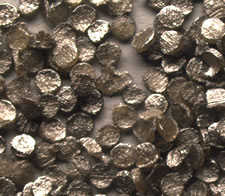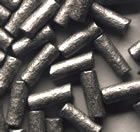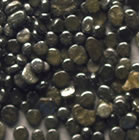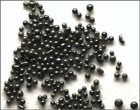- 01: Introduction
- 02: History
- 03: Propellants, Firearms, and Ammunition Development
- 04: Modern Firearms Manufacture
- 05: Small Arms Ammunition
- 06: Evidence Handling Procedures
- 07: Equipment and Instrumentation
- 08: Examination of Firearms
- 09: Cartridge and Shotshell Examination
- 10: Characterization and Evaluation of Fired Projectiles
- 11: Bullet Comparison and Identification
- 12: Gunshot Residue and Distance Determination
- 13: Toolmark Identification
- 14: Communicating Results
- Resources


Morphology
Home > Small Arms Ammunition > Components > Morphology
Early research into nitrocellulose propellants revealed that the shape and size of individual propellant granules controlled the rate of energy release. Solid granules, (the correct term for a single piece of propellant) burn from the outside in. As the surface area reduces with burning, energy release decreases. Likewise, a large granule releases energy over a longer time interval than will a smaller granule. Controlling granule shape and size allows propellants to be customized to specific ballistic requirements.

Flake propellant
Disk or flake propellants are commonly used in low-pressure, low-volume applications such as handgun and shotshell ammunition. Because most of the burn happens from the large flat sides inward, the rate of release is relatively constant until the final stage of the burn cycle. Disk/flake propellants are produced by die extrusion.
Cut sheet or lamelle were the first shape used in modern propellants. They are most commonly used in smaller and/or low-pressure cartridges and the burning characteristics are identical to extruded disks. However, they are not die extruded. The mass of nitrocellulose is pressed between rollers; the vertical spacing between the rollers determines the final thickness of the sheet. The sheet runs through another set of rollers fitted with raised cutting surfaces that cuts the sheet into square- or diamond-shaped pieces.
| Where did the term "Lamelle" come from? |
| The term "lamelle," is from the French for "sheet"—coined by forensic examiner Lucien Haag. |
Cylindrical propellants have greater surface area and fall into the medium to slow energy release category. Some propellants have cylinders that are solid; others have perforation(s) running parallel to the long axis of the cylinder. This allows it to burn both from the outside and the inside, keeping the surface area more uniform to achieve and maintain a constant peak pressure.
Ball powders and flattened ball powders start as nitrocellulose suspended in a solution that is agitated to form balls of varying diameters. These powders cover a large range of small arms needs.
A variant of ball propellant is aggregate ball. Seldom encountered today, it was used as a shotshell propellant until the last two decades. They are so named because each “apparent” granule is an aggregate of smaller balls. The size of these subparticles can vary by a factor of ten.





 Cylindrical or Tubular
Cylindrical or Tubular Flattened Ball Propellant
Flattened Ball Propellant Ball Propellant
Ball Propellant